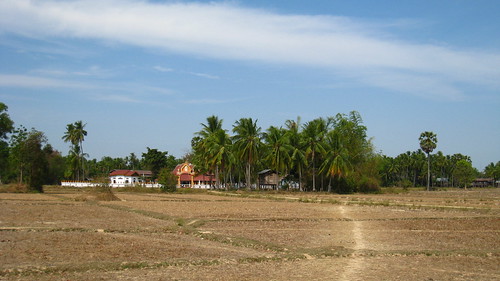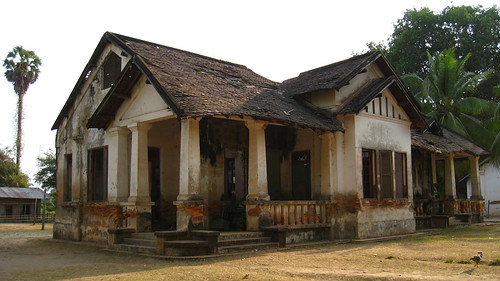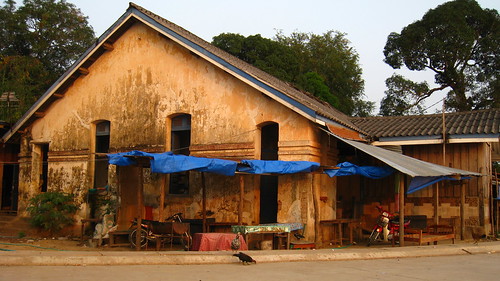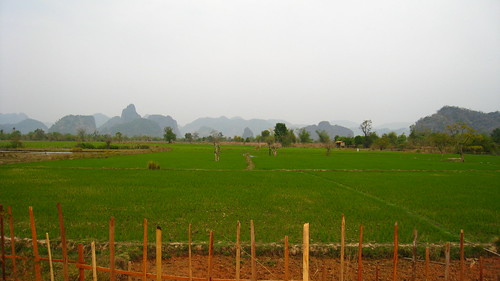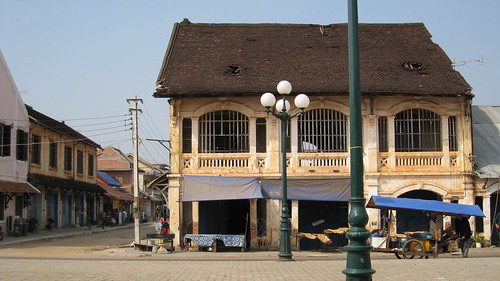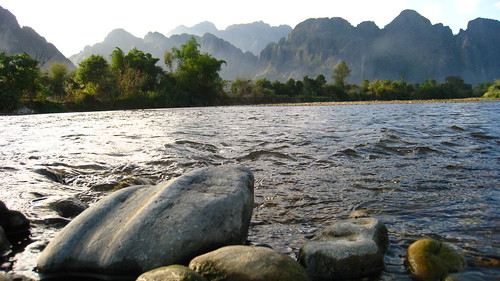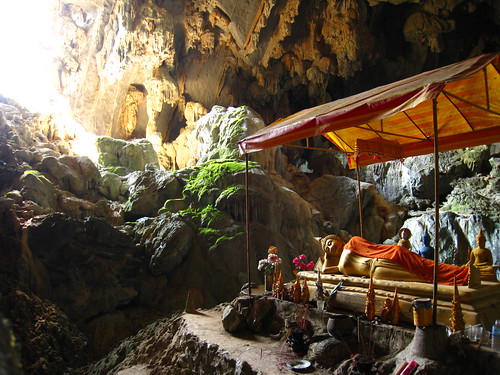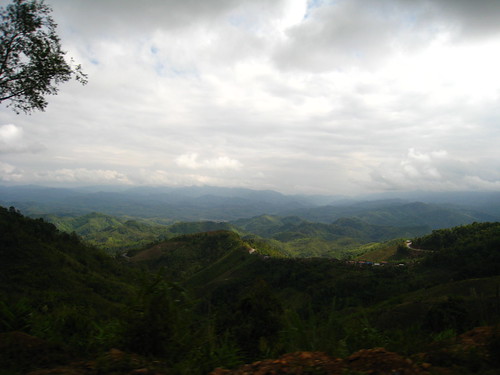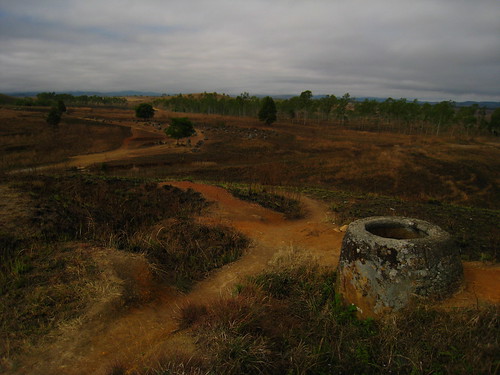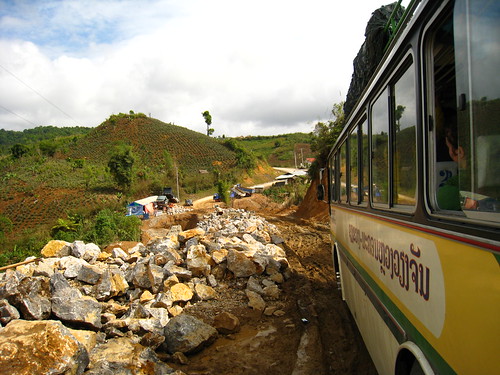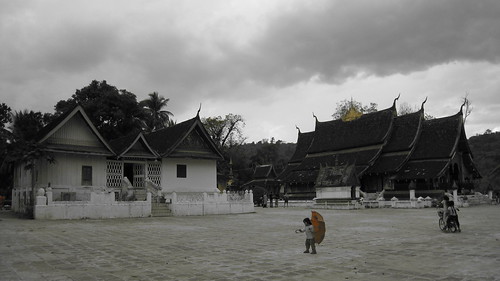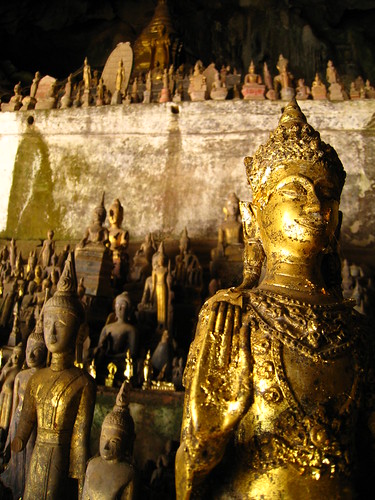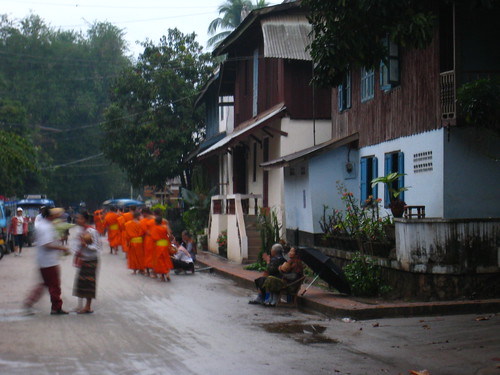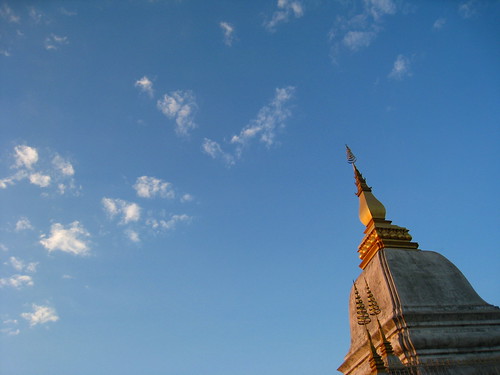 Vientaine is a little bit plain in comparison to Luang Prabang. It feels much more Thai and recent development has scarred the city. It is though still quiet and the people are friendly. Vientaine does not carry a great initial impact. However, I found after a couple of days it has a beguiling charm. Whether its sitting on the esplanade watching the sunset over Don Chan, (the sand island in the Mekong) whicle watching the locals play on the beach, or wandering around a spectacular temple.
Vientaine is a little bit plain in comparison to Luang Prabang. It feels much more Thai and recent development has scarred the city. It is though still quiet and the people are friendly. Vientaine does not carry a great initial impact. However, I found after a couple of days it has a beguiling charm. Whether its sitting on the esplanade watching the sunset over Don Chan, (the sand island in the Mekong) whicle watching the locals play on the beach, or wandering around a spectacular temple. The visit to Kaysone Phomvihane's house just north of Vientaine was a highlight of my stay in Vientaine. Kaysone was the leader of Lao People's Revolutionary Party from 1955, and then Prime Minister of the Lao People's Democratic Republic and then president until his death in November 1992. He lived in the old CIA headquarters from 1976 until his death. The house and his office next door are the picture of understatement. They have remained largely untouched since his death, a time capsule of a communist leader. His shoes are lined up neatly by the door. The whiteboard with his diary for the coming days remains untouched. His winter jacket and suits hang in the wardrobe. The buildings are just bungalows and the interiors do not appear to have been updated since the 1970s. When you walk through the house the only trappings of statehood are gifts from other communist states which appear out of keeping with the rest of the decor. The guides were hugely excited to see me arrive. They were immaculately turned out. They unlocked the buildings and gave me cotton socks to put over my shoes. They were desperately pleased that I signed the guestbook, which was placed on a podium. Both of the guides were thoroughly charming and hoped I would come back soon (they plan to open some more buildings in the compound). The house is a great tribute to Kaysone but it isn't that easy to find. There are no signs from the main road and on my first attempt to find it I cycled passed the entrance. There is a guardhouse with a boom gate where some very nice communist guards looked after my bike. Just around the corner from the house is the bombastic museum built in his honour. There could not be a greater juxtapostion of style.
The visit to Kaysone Phomvihane's house just north of Vientaine was a highlight of my stay in Vientaine. Kaysone was the leader of Lao People's Revolutionary Party from 1955, and then Prime Minister of the Lao People's Democratic Republic and then president until his death in November 1992. He lived in the old CIA headquarters from 1976 until his death. The house and his office next door are the picture of understatement. They have remained largely untouched since his death, a time capsule of a communist leader. His shoes are lined up neatly by the door. The whiteboard with his diary for the coming days remains untouched. His winter jacket and suits hang in the wardrobe. The buildings are just bungalows and the interiors do not appear to have been updated since the 1970s. When you walk through the house the only trappings of statehood are gifts from other communist states which appear out of keeping with the rest of the decor. The guides were hugely excited to see me arrive. They were immaculately turned out. They unlocked the buildings and gave me cotton socks to put over my shoes. They were desperately pleased that I signed the guestbook, which was placed on a podium. Both of the guides were thoroughly charming and hoped I would come back soon (they plan to open some more buildings in the compound). The house is a great tribute to Kaysone but it isn't that easy to find. There are no signs from the main road and on my first attempt to find it I cycled passed the entrance. There is a guardhouse with a boom gate where some very nice communist guards looked after my bike. Just around the corner from the house is the bombastic museum built in his honour. There could not be a greater juxtapostion of style.  The museum is fronted by a huge staue of comrade Kaysone. The building is huge and they have only managed to fill most of the second floor. The ground floor is completely empty. The second floor isn't even full of Kaysone displays, one section is taken up purely by photographs from communist party meetings, a large amount of the content is borrowed from the revolutionary war section of the national museum. There are a great number of communist guards hanging around the building. I had one guarding my bike outside. The architects managed to work in one of those 'god' circles which magnifies sound when you stand in it. It is at the top of the stairs to the second floor and a large statue of Kaysone watches over it. I amused myself clapping my hands and stamping my feet, which didn't seem to surprise any of the guards watching on. I was of course the only visitor, much like the forgotten busts of Kaysone Phomvihane in every town in Laos, the capital city and country seems to have forgotten there is a huge museum (and a small house) waiting to be revered.
The museum is fronted by a huge staue of comrade Kaysone. The building is huge and they have only managed to fill most of the second floor. The ground floor is completely empty. The second floor isn't even full of Kaysone displays, one section is taken up purely by photographs from communist party meetings, a large amount of the content is borrowed from the revolutionary war section of the national museum. There are a great number of communist guards hanging around the building. I had one guarding my bike outside. The architects managed to work in one of those 'god' circles which magnifies sound when you stand in it. It is at the top of the stairs to the second floor and a large statue of Kaysone watches over it. I amused myself clapping my hands and stamping my feet, which didn't seem to surprise any of the guards watching on. I was of course the only visitor, much like the forgotten busts of Kaysone Phomvihane in every town in Laos, the capital city and country seems to have forgotten there is a huge museum (and a small house) waiting to be revered.
Vientaine is in many ways a nondescript sort of a place. Vientaine represents the rest of the country very accurately, it is relaxed, quiet and without crowds of people. While war did not touch it (it was considered neutral by both sides) modern development has. It looks like any other small town in Vietnam or Thailand. It could be Quy Nhon or Krabi. What sets Vientaine apart is just how quiet and relaxed it is. I've not come across a capital city like it, other than Canberra. Canberra isn't so much relaxed as lacking in people. Unlike Canberra it doesn't have the excuse of two much larger cities to draw attention. While Luang Prabang is the epicentre of tourism with the architecture and scenery, Vientaine is the political and business capital and is the largest city in Laos.
While Vientaine is quiet, tuk-tuk have still descnded upon it like nowhere else in Laos. When our bus arrived from Vang Vieng at Talat bus station they were lined up at the entrance watching the buses drive in. When they caught sight of western faces a stampede developed as they chased the bus. By the time the bus doors opened at least 30 tuk-tuk drivers were swarming the entrance shouting 'where you go, where you go'. The only thing that stopped this chorus was when I got off and whacked my head on the door frame, which was greeted by a group 'oh'. (I was surprised it wasn't greeted by a chorus of laughter, the typical response in South-East Asia). We walked the short distance into the centre of town. Tuk-tuk drivers are parked all over the city (and the city really isn't that big) and you are constantly asked 'where you go'. Alot of the tuk-tuk drivers speak English quite well and you wonder whether they could not put their skills to better use. It shows that either other opportuntiies do not exist or the money made being a tuk-tuk driver outweighes other occupations.
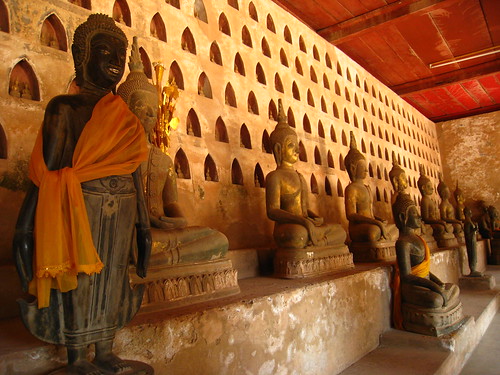 While Vientaine isn't eye catching there are some sights worth seeing. Wat Si Saket is the most beautiful temple I have seen in Laos. It rivals Wat Phra That Lampang Luang (near Lampang in Thailand). Wat Si Saket feels old and unique. A cloister surrounds the Sim with large buddhas lined up and tiny buddhas sitting in niches in the walls behind them. The Sim is even more beautiful with a large seated buddha surrounded by smaller buddhas and the walls are again filled with niches and tiny buddhas. There are about 7000 buddhas in total. Pha That Luang is a stunning sight from afar. It is a giant golden stupa and against a pefectly blue sky it really shines. Admittedly there isn't a great deal to see once you get up close. Xieng Khuan (known as Buddha Park) is another place well worth visiting. It is the eccentric fusion of Hindu and Buddhist religious thought in the form of sculpture. There is a giant pumpkin sculpture which you can climb inside, depicting hell, earth and heaven. If you climb up the inside you appear out of the mouith of a sculpture on the top of the pumpkin. The park is only 20kms from the city centre but most of the journey takes place on pot-holed dirt tracks filled with clouds of dust. It seems that the money for the Friendship Bridge (border crossing into Thailand) paid for the road up to that point and they haven't got around to finishing the rest. I've not come across a capital city where only 20kms from the centre you come across a well used road in this condition. Our bus was packed to the rafters. On board was a US-Lao citizen who had left the country in 1976 after the communists had taken power and has only been back in Laos for the passed two years. A sight you cannot miss is Patuxai the Laos equivalent of the Arch de Triumph built with concrete the Americans intended for a new runway at the airport. From afar it looks quite impressive, but the closer you get the uglier it appears. An apt label has been painted on its side, "From a closer distance, it appears even less impressive, like a monster of concrete".
While Vientaine isn't eye catching there are some sights worth seeing. Wat Si Saket is the most beautiful temple I have seen in Laos. It rivals Wat Phra That Lampang Luang (near Lampang in Thailand). Wat Si Saket feels old and unique. A cloister surrounds the Sim with large buddhas lined up and tiny buddhas sitting in niches in the walls behind them. The Sim is even more beautiful with a large seated buddha surrounded by smaller buddhas and the walls are again filled with niches and tiny buddhas. There are about 7000 buddhas in total. Pha That Luang is a stunning sight from afar. It is a giant golden stupa and against a pefectly blue sky it really shines. Admittedly there isn't a great deal to see once you get up close. Xieng Khuan (known as Buddha Park) is another place well worth visiting. It is the eccentric fusion of Hindu and Buddhist religious thought in the form of sculpture. There is a giant pumpkin sculpture which you can climb inside, depicting hell, earth and heaven. If you climb up the inside you appear out of the mouith of a sculpture on the top of the pumpkin. The park is only 20kms from the city centre but most of the journey takes place on pot-holed dirt tracks filled with clouds of dust. It seems that the money for the Friendship Bridge (border crossing into Thailand) paid for the road up to that point and they haven't got around to finishing the rest. I've not come across a capital city where only 20kms from the centre you come across a well used road in this condition. Our bus was packed to the rafters. On board was a US-Lao citizen who had left the country in 1976 after the communists had taken power and has only been back in Laos for the passed two years. A sight you cannot miss is Patuxai the Laos equivalent of the Arch de Triumph built with concrete the Americans intended for a new runway at the airport. From afar it looks quite impressive, but the closer you get the uglier it appears. An apt label has been painted on its side, "From a closer distance, it appears even less impressive, like a monster of concrete".
The national museum in the centre of Vientaine is a clear example of changing times in Laos. The museum used to be called the Lao revolutionary museum. The exhibits dedicated to the revolution are dated and talk of the American imperialist and his puppets or stooges. There are weapons lying around, including rifles that brought down jet fighters. There are personal artefacts including Kaysone's 'chest expander'. The newer exhibits relate to historical discoveries and ancient cities. There is also an exhibit on Gerrit van Wrysthoff who visited Vientaine in 1641 as an envoy of the Dutch East India Company, the most modern exhibit paid for by the Dutch government.
The Dutch exhibit is another sign of changing times. If you are an NGO or a foreign government and you have the money in a poor country such as Laos you can pretty much do what you want. It is an issue covered by Brett Dakin in 'Another Quiet American' regarding his time working in the Laos National Tourist Authority. It is an interesting insight into life as an expat in Vientaine. Dakin directs strong criticism at what he sees as westerners who work for foreign governments and NGOs, travelling the globe from one undeveloped country to another being paid six figure salaries and not being of great use to the country they are supposedly helping. He argues that their salaries would be of much better use simply given as aid. Dakin also gives an insight into life for Lao under a one-party dictatorship. In the National Tourist Authority promotion and credit goes to those who are in favour with the communist regime rather those who do a good job. Accommodation in Vientaine, much like Luang Prabang, is overpriced compared to the rest of the country. Also like Luang Prabang most of it seemed to be full. I stayed at Joe's Guesthouse on the riverfront for 50,000 Kip for a single room with shared bathroom. It was a very small room, but it was clean (so were the shared bathrooms) and the staff were friendly in an abrupt manner.
Vientaine's southern bus station is 8kms north of the city. It is apparently 60,000 Kip to hire a tuk-tuk to take you there. I booked a ticket, including a tuk-tuk to the station, with DD Travel (on a side street from Wat Mixay near the riverfront) to Thaket for 115,000 Kip (the bus journey alone should cost 65,000 Kip). I was picked up at 5.30am. In typical Laos fashion we were rushed onto a bus as it was pulling out of the station only for it to drive out of the bus station and pull up 5 minutes down the road where we waited half an hour while being assaulted by food and drink vendors.
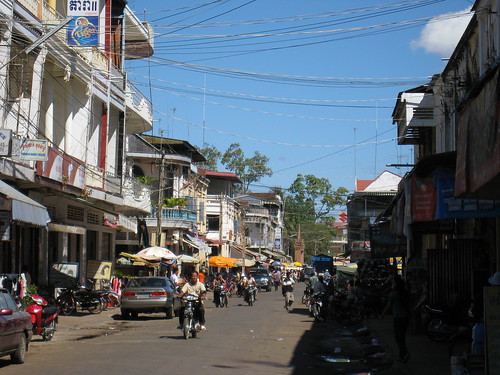 Having alot of time I was able to stay in some Cambodian towns on the Mekong. I stopped in Stung Treng, Kratie, and Kompong Chom on my way to Siem Reap. In many respects they are very similar. They are all based around a central market (Psar) and they all have architecture that has survived the ravages of the Khmer Rouge, the Vietnamese Army, American B-52 bombers, and the more peaceful though no less destructive modern development. Of the three I would suggest Kratie is the best one to visit.
Having alot of time I was able to stay in some Cambodian towns on the Mekong. I stopped in Stung Treng, Kratie, and Kompong Chom on my way to Siem Reap. In many respects they are very similar. They are all based around a central market (Psar) and they all have architecture that has survived the ravages of the Khmer Rouge, the Vietnamese Army, American B-52 bombers, and the more peaceful though no less destructive modern development. Of the three I would suggest Kratie is the best one to visit. 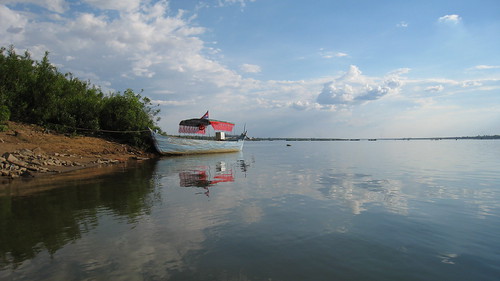


 Papa, aka Mr Souksanh, runs with his family his namesake guesthouse. He is a 50 year old, has three children, and expecting a fourth with his second wife (his first wife died last year). One of the stranger culture gaps I found was Papa showing a photo album from his first wife's funeral, including pictures of him and his children crying infront of her urn. Papa is a small guy but surprisingly strong highlighted by his ability to drag you off to meet other guests. He has incredibly cracked feet, generally he walks around with plasters on. I think its due to being in and out of the long boat into the water regularly. Papa's English is tempremental, depending upon what you are asking and how much lao-lao he has had to drink. I spent ten minutes trying to explain walking across a log (which we had done on a boat trip with him that morning) with my phrasebook, which turned into charades. The people of Laos like to drink, either the legendary Beer Lao or the more potent lao-lao. The drinking of rice wine is popular throughout South-East Asia. However, unlike Western consumption of alcohol it doesn't seem to lead to violence. Papa liked his lao-lao more than most. Lao-lao is the Laos take on rice whiskey distilled by local people from femented rice. It is a strong spirit that bears more in relation to vodka than whiskey. Papa spent most of his time drunk. I went on boat trips with him driving the long boat and he was very competent at what he was doing whilst still being drunk. I did two boats with him one to Khon Phapeng (75,000 Kip), and the other to Don Som (50,000 Kip plus 10,000 Kip entry fee levied by the local villagers). There are lots of tours offered to Khon Phapeng, however, all of these tours go along the mainland and drop you at a viewing gallery. Papa on the other hand takes you by boat on a very scenic journey, down the Mekong through the ebb and flow of the islands and rapids. He 'docks' the longboat in a shallow inlet, where upon he lead us down a dried out arm of the waterfall over old fish traps to appear right infront of the waterfall. Up close and personal Khon Phapeng is particularly impressive. There was the obligatory lao-lao to honour the souls of the dead that the Lao and Thai believe are trapped in Khon Phapeng. On the trip to Don Som Papa took us down the Mekong to another island where we walked, climbed and scrambled our way to a small waterfall and rapids. We swam in the fast current and jumped into the plunge pool. I swallowed alot of Mekong water during this and when I surfaced from the jump Papa gave me a glass of stronger than normal lao-lao. Papa caught us a fish and we barbecued it at the rapids. On the journey back Papa anchored us on a bush in the Mekong and jumped in to collect snails from the river bed. A couple of guys followed him in and weren't quite as successful. Papa is extremely proud of the guests who stay for a long time. It is almost guaranteed that you will end up staying longer than you originally plan. Papa is very persuasive. One guy stayed for 2 months, others a month at a time. While I was there a French couple who stayed a month last year were back and again staying for a month. They had intended to stay for 2 weeks and then go to Cambodia but were persuaded otherwise. Papa regularly invited me to join him for lunch or snacks, and he didn't charge me. If the Beer Lao gets flowing then Papa will contribute a couple of bottles. On my first day he dragged me over to a bungalow where the French couple and an Anglo-Swiss couple were chatting. The French couple tried to explain my name to Papa so it would be easy for him to pronounce. They used 'steamed' becuase of the similar sound, which became 'Steamed rice not sticky rice', shortened to simply 'sticky rice' for the duration of my stay. He brought some Beer Lao bottles and then invited us inside to watch Thai boxing with him and his family. We ended up betting bottles of Beer Lao on the various fights, Si Fa or Si Daeng (Red or Blue). When I left for Cambodia Papa took me by boat to the mainland. Before I left we settled the bill which they had an under charged me, by not adding in the cost of the accommodation, I added it and paid them the correct amount. Papa then tied a piece of string around my wrist, so did Mama, and so did the French couple, followed by an obligatory shot of lao-lao (at 8am). The string tying ceremony is a Lao custom. The French couple were having a new long boat built for Papa (they were paying half, Papa was paying the other half). The building of the boat involved so many string tying ceremonies that it looked like they had plastercasts on both of their wrists.
Papa, aka Mr Souksanh, runs with his family his namesake guesthouse. He is a 50 year old, has three children, and expecting a fourth with his second wife (his first wife died last year). One of the stranger culture gaps I found was Papa showing a photo album from his first wife's funeral, including pictures of him and his children crying infront of her urn. Papa is a small guy but surprisingly strong highlighted by his ability to drag you off to meet other guests. He has incredibly cracked feet, generally he walks around with plasters on. I think its due to being in and out of the long boat into the water regularly. Papa's English is tempremental, depending upon what you are asking and how much lao-lao he has had to drink. I spent ten minutes trying to explain walking across a log (which we had done on a boat trip with him that morning) with my phrasebook, which turned into charades. The people of Laos like to drink, either the legendary Beer Lao or the more potent lao-lao. The drinking of rice wine is popular throughout South-East Asia. However, unlike Western consumption of alcohol it doesn't seem to lead to violence. Papa liked his lao-lao more than most. Lao-lao is the Laos take on rice whiskey distilled by local people from femented rice. It is a strong spirit that bears more in relation to vodka than whiskey. Papa spent most of his time drunk. I went on boat trips with him driving the long boat and he was very competent at what he was doing whilst still being drunk. I did two boats with him one to Khon Phapeng (75,000 Kip), and the other to Don Som (50,000 Kip plus 10,000 Kip entry fee levied by the local villagers). There are lots of tours offered to Khon Phapeng, however, all of these tours go along the mainland and drop you at a viewing gallery. Papa on the other hand takes you by boat on a very scenic journey, down the Mekong through the ebb and flow of the islands and rapids. He 'docks' the longboat in a shallow inlet, where upon he lead us down a dried out arm of the waterfall over old fish traps to appear right infront of the waterfall. Up close and personal Khon Phapeng is particularly impressive. There was the obligatory lao-lao to honour the souls of the dead that the Lao and Thai believe are trapped in Khon Phapeng. On the trip to Don Som Papa took us down the Mekong to another island where we walked, climbed and scrambled our way to a small waterfall and rapids. We swam in the fast current and jumped into the plunge pool. I swallowed alot of Mekong water during this and when I surfaced from the jump Papa gave me a glass of stronger than normal lao-lao. Papa caught us a fish and we barbecued it at the rapids. On the journey back Papa anchored us on a bush in the Mekong and jumped in to collect snails from the river bed. A couple of guys followed him in and weren't quite as successful. Papa is extremely proud of the guests who stay for a long time. It is almost guaranteed that you will end up staying longer than you originally plan. Papa is very persuasive. One guy stayed for 2 months, others a month at a time. While I was there a French couple who stayed a month last year were back and again staying for a month. They had intended to stay for 2 weeks and then go to Cambodia but were persuaded otherwise. Papa regularly invited me to join him for lunch or snacks, and he didn't charge me. If the Beer Lao gets flowing then Papa will contribute a couple of bottles. On my first day he dragged me over to a bungalow where the French couple and an Anglo-Swiss couple were chatting. The French couple tried to explain my name to Papa so it would be easy for him to pronounce. They used 'steamed' becuase of the similar sound, which became 'Steamed rice not sticky rice', shortened to simply 'sticky rice' for the duration of my stay. He brought some Beer Lao bottles and then invited us inside to watch Thai boxing with him and his family. We ended up betting bottles of Beer Lao on the various fights, Si Fa or Si Daeng (Red or Blue). When I left for Cambodia Papa took me by boat to the mainland. Before I left we settled the bill which they had an under charged me, by not adding in the cost of the accommodation, I added it and paid them the correct amount. Papa then tied a piece of string around my wrist, so did Mama, and so did the French couple, followed by an obligatory shot of lao-lao (at 8am). The string tying ceremony is a Lao custom. The French couple were having a new long boat built for Papa (they were paying half, Papa was paying the other half). The building of the boat involved so many string tying ceremonies that it looked like they had plastercasts on both of their wrists.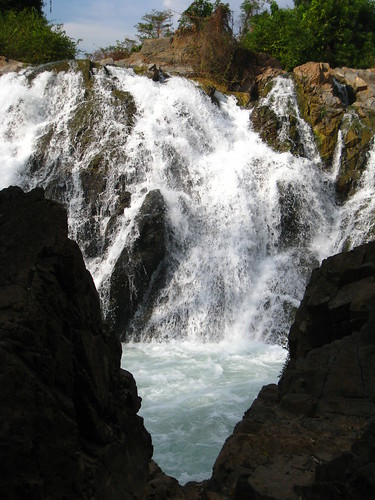 Souksanh Guesthouse is very much a family affar. The older children and the wife do most of the work. They are very friendly. The food is pretty good and a good price. Although what you ordered and what you received weren't always the same thing. The girls taking your order would smile and laugh and I couldn't discern whether that was because I was sticky rice or whether it was because they didn't understand what I was going on about. There are better places to eat on Don Khon though they are more expensive. The accommodation is excellent value. There are three bungalows with ensuites for 50,000 Kip and double rooms with shared bathrooms for 30,000 Kip. Papa was in the process of building ensuites on to the double rooms (so prices will go up). There is a shared veranda that streches across the front of the double rooms. The only problem with the double rooms is they can get quite hot come the evening after heating up during the day, and the fans for the room (and the lights) remain on until around 9pm or when the film the girls are watching on TV finishes. The bungalows are made from traditional materials so are cooler.
Souksanh Guesthouse is very much a family affar. The older children and the wife do most of the work. They are very friendly. The food is pretty good and a good price. Although what you ordered and what you received weren't always the same thing. The girls taking your order would smile and laugh and I couldn't discern whether that was because I was sticky rice or whether it was because they didn't understand what I was going on about. There are better places to eat on Don Khon though they are more expensive. The accommodation is excellent value. There are three bungalows with ensuites for 50,000 Kip and double rooms with shared bathrooms for 30,000 Kip. Papa was in the process of building ensuites on to the double rooms (so prices will go up). There is a shared veranda that streches across the front of the double rooms. The only problem with the double rooms is they can get quite hot come the evening after heating up during the day, and the fans for the room (and the lights) remain on until around 9pm or when the film the girls are watching on TV finishes. The bungalows are made from traditional materials so are cooler.